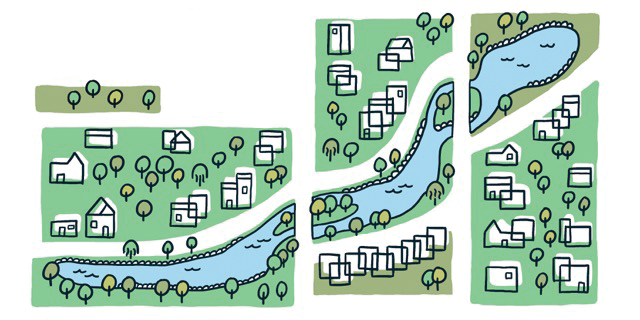On a map, Auburn Park appears as an unexpected departure from the city grid, its thin fingerlike lagoons passing under two narrow bridges on Normal and Eggleston Avenues. On the ground, the abrupt break into open space feels like a sudden entry into a small town within Auburn Gresham—and indeed, that was always the intended effect. Auburn Park harkens back to an earlier era of Chicago’s development, when the railroads and heavy-handed real estate speculators shaped the city.
The land now occupied by the park was originally marshy and uninhabitable. It was owned by Chicago’s first mayor, William B. Ogden, and drained and platted (surveyed in order to divide it into saleable parcels) in 1872 by the reputed Eggleston, Mallette & Brownell—in 1891 it was written of the firm that “there are few in Chicago more expert in laying out property and supervising its drainage, sewerage, paving, macadamizing, etc.” At this time, there were many opportunities for speculators to make money platting land in anticipation of the southward spread of the city, which expanded outward from the railroads being laid in the area. At the turn of the twentieth century, the South Side of Chicago became increasingly appealing as an escape valve of sorts, a place to plan beautiful communities away from the bustle of the city center.
In the late nineteenth century, Auburn Park lay between two veins of industry. Vincennes Avenue, to the park’s immediate east, was known as one of the South Side’s great thoroughfares, among the first to be served by horse-car lines by 1889. The park’s combination of proximity to and quiet separation from this major artery made the surrounding community a desirable place to call home.
Directly to the west sat the Chicago, Rock Island and Pacific Railroad, whose workers comingled with the area’s real estate developers—this explains the juxtaposition of squat bungalows and larger Victorian homes along Winneconna Parkway, the curving street that follows the lines of the lagoon. The park’s lagoon was intended to echo the area’s original marshland.
Auburn Park has long been a recreational space for Auburn Gresham residents. Irene Casey, who grew up nearby at 80th and Union in the 1940s and 1950s, recalls ice-skating in the park and walking around it in the summertime. Her family moved a few miles southwest to the Mount Greenwood neighborhood in 1965, where she still lives, citing Auburn Gresham’s midcentury economic decline.
“There used to be so much shopping there, but now there’s nothing,” she says.
As the neighborhood fell onto harder times and vacant lots and storefronts came to dot Winneconna Parkway and Auburn Gresham’s 79th Street commercial strip, Auburn Park has remained steadfastly in place, a reminder of the beginning of the city’s development.


I think that Studds Lonigan, James T. Farrel’s novel about growing up in the then-Irish South Side in the latr 20’s and early 30’s tells a story about ice skating under city street bridges, and as far as I can tell, he’s talking about Auburn Park. I can’t find anywhere else on the South Side where this could have taken place. His family belonged to St. Gabriel Parish.
Posting again just to get an email if there is a reply.
If you are Irene Casey and grew up at 80th & Union, so did I! We lived at the corner of 80th and Union at 650 West 80th from about 1954/55 to the spring of 1957/58. Does that synchronize with your experience?
My uncle took me ice skating there when I was about 4yo in1949. My mom took us there in the summer to fish. The best memories from that time. Family lived at 76th Union.
Was there a hospital called Auburn Park hospital in the 1930s? Per my grandmother’s 1930 census she was a student nurse.
My mother and her identical twin were born at Auburn Park Hospital at 449 Winneconna Parkway, across from the park in 1930. There are now houses there.